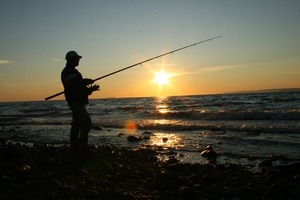{This is part F of my Alphabet Soup series of articles. This is a 26-part series, one article per week.}
Fluke fishing is a popular pastime in New Jersey. Fluke are not too difficult to catch once you know the basics. Here is a guide for catching fluke in New Jersey.
What is a fluke?
A fluke is a popular game fish in New Jersey. Fluke are also known as a summer flounder for their flat appearance. Fluke can grow to more than 30 inches in length and weigh as much as 20 pounds. However, fishermen typically catch fluke in the area of 1 to 3 pounds. An 8-pound fluke is considered large. The top of the fluke is dark brown, while the bottom is white. Both of its eyes appear on the top. Fluke generally feed off the bottom of the ocean, but will sometimes rise from the bottom to feed.
What are the fluke fishing regulations?
For 2011, the fluke season runs from May 07 to Sept 25. Any fluke caught outside of this season must be released. The fluke size limit is 18 inches. Smaller fluke must be released. An angler may keep up to eight fluke. Fishermen are required to register with the state of New Jersey in order to fish in saltwater. You can register for free online at this link: New Jersey Saltwater registry.
Where can you catch fluke?
Fluke can be caught in saltwater all along the New Jersey shore. They can be caught from the shore, around jetties, at piers and in the bays. Wherever there is saltwater, you can find fluke. Fluke can also be caught off shore from boats. Fluke stay near the bottom, looking for baitfish and other food.
What equipment do you need?
Any rod and reel can be used to catch fluke. A typical set-up would be a medium-action 7-foot rod with a spinning reel filled with 15-pound test fishing line. The only other thing you’ll need is bait.
How do you catch fluke?
The classic way to catch fluke is to use a fluke rig and bounce it off the bottom of the ocean. A popular fluke rig consists of a 3-way swivel, 2-ounce sinker and fluke hook. You can find all these items at your local tackle shop or department store. The sinker is attached to one connector on the swivel. I prefer tying the sinker to the connector with fishing line since sinkers can get snagged on the bottom. When snagged, the sinker connection will break and you can recoup the rest of your rig. The leader of the fluke hook is inserted through another connector on the swivel. The hook is then passed through the loop of the leader and pulled tight. This is how you attach the hook to the swivel. That completes the fluke rig. The last step is to attach your fishing line to the last open connector on the rig. A Palomar knot is a great choice here. Fluke rigs can be purchased, but I prefer to make my own and save money. Always have spare rigs ready. When you’re fishing off the bottom, snags can happen.
A popular choice for bait is a strip of squid along with a spearing. Once baited, cast your rig as far as you can. Then, proceed to reel the rig in while bouncing it off the bottom. It is important to hit the bottom since that is where the fluke stay. If the current is too strong, use a heavier sinker to ensure that you hit the bottom.
Repeat the process while checking your bait each time. If the fluke are out there, they will hit. This is just one way to catch fluke. They can also be caught with lures such as buck tails, twister tails and live bait. Fluke are not picky. If you find them, they will strike. Also try to fish on the moving tide. That would be two hours before and two hours after high/low tide. Fluke tend to be active during moving tides as they search for bait fish.
Good luck and happy fishing!
